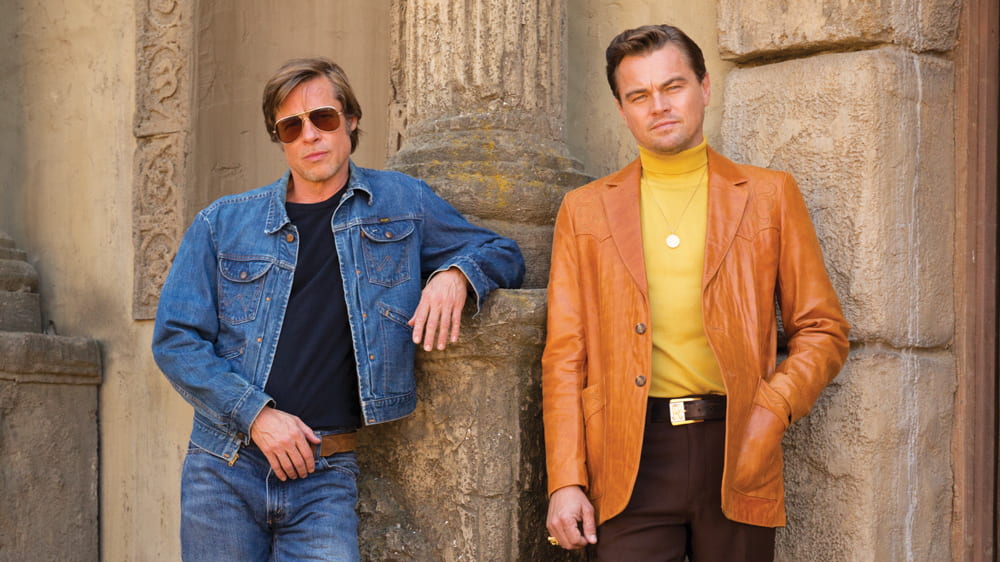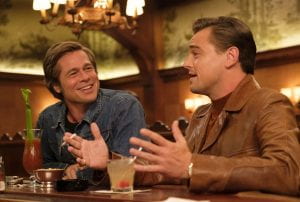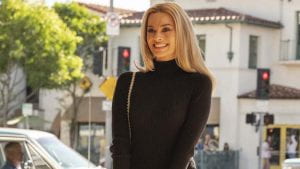Way back in March, we saw the world premiere of The Art of Self-Defense at SXSW. The film centers on Casey (Jesse Eisenberg) who is determined to muscle up by joining a karate dojo after becoming the victim of a brutal mugging that leaves him shaken and traumatized. At the time,
we praised it for its dark and humorous take on toxic masculinity, and how it’s a film that’ll “make you think twice before you caveman that beer in front of your friends.”
Fast forward two months and the film made another appearance at the Seattle International Film Festival, and along with it came writer-director Riley Stearns. During the festival, we had the opportunity to speak with the director and discuss where the idea came from, the process of scripting such a tact-sharp comedy, and whether or not he himself knows karate.
Below you’ll find a written transcript of the interview as well as the audio recording of our discussion with Stearns. The interview has been edited for clarity and readability.
G: One of the themes in The Art of Self-Defense deals with toxic masculinity and the absurdity of it all. Where did the idea come from and what set you in motion?
R: The initial feeling is one I think a lot of men have and one they aren’t willing to admit having and that is they don’t feel like they’re enough of a man. I didn’t feel like I was as masculine as other guys presented themselves as, and I didn’t know that I related to men in the same way that I was supposed to. I kinda wanted to explore what that meant.
That was also how i got into jujitsu without even realizing it. I started out as, “Oh I want to learn how to defend myself, and I’m super into watching MMA fights, but this jujitsu element seems really cool.”
The deep-seated thing in my head was that I don’t understand who I am. It came from a real place of wanting to deconstruct what it means to be a man, and tackle it in a super literal way. And if you present these things as literal as possible, then it can be easy to see how absurd it is.
G: The scenarios are very spot on. You talked about how literal it is at times. For example, not being able to learn French because it’s a feminine language. It’s like a hyperrealistic form of our own reality that’s not so far removed from experiences in normal conversation.
R: Yah, people have over the years said that sort of thing, and that’s why it’s so dumb. This is something we’ve heard before, but we’re gonna say it even more in the film — it’s gonna be louder. There’s a scene where — and I don’t think I realized it as I was writing it — when Alessandro [Nivola — Sensei in the film] is explaining masculinity versus femininity to Casey, he says the word masculine four or five times in the scene. It’s just hammering it home. It’s being super overt and that’s where the humor lies for me . . . being as on the nose as possible in some scenes.
In other scenes, you can be more subtle. People are very black and white about how they present their thoughts and feelings. Imogen’s [Poots — Anna in the film] character is the one who can present the gray area. Sensei is super on the nose. Jesse is just like a sponge that soaks up everything he is learning. Imogen gets to play devil’s advocate and fill the role of the audience. I liked exploring all those thoughts in a comedic way.
G: One other question I had was how early on did Jesse Eisenberg sign on to the project because he fits that role very well.
R: It’s so weird to think about it now, but at one point his name was brought up, and I said, “No he’s not right for it.” The initial idea was that Casey was supposed to be in his forties so it would be even more ridicules and sad that a middle-aged guy wasn’t feeling like a man. And when he signs up for something like karate, I thought of how ridiculous that would look — like jumping, kicking and punching along side teenagers in the class. I was really set on that age for a while, so when Jesse’s name was first brought up, I thought, “He’s not the right age,” but as we went down that path, we began to realize a lot of guys around that age didn’t feel like they could do the role.
I had one actor tell me in an email something along the lines of he didn’t want to play a weak character. That kind of struck me, and made me realize why I wanted to make a movie like this. Like, why is Casey considered weak? He’s just trying to figure out who he is, so why is that weak? He’s actively trying to better himself and figure out who he is for himself instead of letting expectations define him.
When Jesse’s name was brought up later on, it kind of just clicked. The fact that he got the script as well as he did, it was a no brainer, but at the same time, that also meant once he said ‘yes’ his schedule was very finite with regards to how much we could shoot with him. He was coming off a project and had another one starting at the end of the year after Self-Defense. He said he wanted to make it in late June or early July 2017, so the second he said that, we started prepping in Kentucky. I think we were in Kentucky in August 11th until September 11th.
So from the beginning of July to September 11th, that’s the amount of time we had with Jesse from him saying, “Ok, I want to do it. Figure it out,” and actually shooting. It was a 25 day shoot. It was fast and by the seed of your pants sort of thing, but we did it. It’s still insane to think that we were able to put everything together in the way that we did.

G: The film works in a lot of dark, dry pan humor. Do you have any personal inspirations that worked their way in there?
R: I don’t necessarily feel like I’m inspired by films while I’m writing. I want it to feel like a world with my own thoughts and views. I’d say in general that people who inspire me are Paul Thomas Anderson, Hal Ashby, Yorgos Lanthimos… I really respond to people who like to blend tones … oh, the Coen Brothers for sure. People who blend tones and aren’t afraid of making people uncomfortable for laughing at something really dark or uneasy. That kind of stuff is fun for me. In terms of tone, I definitely borrow from those people. I’m very inspired by them, but I definitely don’t try to give an homage to something or put other people’s shots into my movies. That’s just the way that I work.
G: When I was watching The Art of Self-Defense, the first thing I connected it to was Dr. Strangelove and how that situation is very similar to this film — that being a serious situation that’s set to absurdist escalation.
R: That’s super cool to hear you say. I actually hadn’t thought of that film with regards to this movie in a long time, but when I first put together a director’s packet and I was sending the script to certain producers to get the feel if people wanted to work on it, I did mention Dr. Strangelove as a film The Art of Self-Defense could be loosely inspired by tonally. I hadn’t thought of that in forever, but I remember that.
G: Tone management for a comedy is very important. Your film goes from an absurdist comedy to being pretty serious about its subject— it reaches a tipping point where it is no longer a funny. Spoilers, but Casey ends up carrying out the same acts of violence that were committed against him.
R: He becomes a tool for Sensei’s machine. It’s fun to play around with that . . . to have a character that you are relating to go down a path that you know is wrong and still hope that they come out on the other side in a positive way. Being able to play around with the darkness while they’re in it is fun.
G: How many revisions of the script did you do?
R: Zero. I don’t like to rewrite. It’s probably out of laziness more than anything. Faults [Stearns’ first feature] is a first draft. The Art of Self-Defense is a first draft. I say first draft as in the script is what it is. What is in the movie is on the page. That first draft gets modified dialog and situations change here and there, but for the most part, the shooting script is almost identical to the first draft. It’s not that I’m not thinking about it though. I think about a movie for up to a year before I start writing it.
That time is coming down because I just want to do more things, but I like to really figure out exactly what I want to happen— in terms of structure —and then fill in the blanks with writing. That’s the fun part, discovering fun things that happened or making a good callback. That sort of stuff isn’t what I think about when I make the story’s structure, but I usually let the idea percolate a while before I start writing. I’ve almost done all the rewrites before I start writing. It’s not just like I go in blind and be like, “Oh, he does this and then that which leads to this.” I know what I want to do, and then when I don’t do a rewrite, it’s because I’m lazy.
G: You usually hear stories about actors or producers who give input and then the script goes through rewrite after rewrite to the point where the original is a distillation of the original script.
R: I’m in a very lucky position where for two movies now, I’ve met producers who trusted my perspective and vision. Keith Calder and Jess Calder [producers on Stearns’ first feature] for Faults loved the script. That script is a first draft, and it ended up on the Black List that year — I think it was top ten for that year, what ever that means. People liked it and it was great. People would say, “Well, if I would do that script, I would need another ten rewrites.” Well, then you aren’t the right producer for it. I’m looking for the things I want to make and I hope I find people who want to do the same. When I send the script out, that’s the film.
Self-Defense was the same thing. I found Andrew Kortschak [producer on the film] and he got what I wanted to do, trusted that vision, and didn’t make me rewrite anything. The edit was where we go to collaborate. If something really isn’t working, that’s where we talk about it and have back and forths. But yah, if you want me to do ten rewrites on something, then we’re not gonna be the right team. I’ve gotten to the point now where I don’t have to worry about that. On this next movie I’m working on called Dual, I met these producers who are incredible and make really incredible movies. They are trusting me to be like, “This is the script. This is what we’re making,” and they’re not coming in and changing anything.

G: I don’t know how much you can say about it, but how different will Dual be from your prior works?
R: It’s definitely in the same vein. It’s more along the lines of Self-Defense than Faults in the sense that it is more heightened and pseudo-sci-fi. There’s a cloning element involved with a female lead. It’s its own beast, but still very dark and very comedic. I don’t think I would be able to make something that isn’t funny — not in an egotistical way — but i just like making stuff that’s funny, so I’m not gonna try to make something that is exclusively dramatic. I’m always gonna be trying to have a sense of humor about something. That’s something that’s always gonna stick in my work hopefully.
G: The comedic payoffs in this film are really good, especially with the finger technique punchline. When you are writing, are you threading these jokes into the film as you are writing it?
R: There’s two things that come to mind. It goes back to the idea of filling in the blanks after the structure is there. In Faults, there is a part in the beginning when the two characters get to the motel and one of them reverses the door knob so that the other character can’t lock herself in the bathroom. He reverses the knob so he has control of the lock. That was just something I had in my head for the narrative.
I didn’t think anything of it until later on when I got to a scene where the two were gonna have to be trapped in a confined space. I realized that would be how they’d be forced to talk. It was something that came about as I was writing. It wasn’t planned, but it became a cool callback, and I really love those.
Self-Defense has moments like that too, in particular that finger moment that you brought up. Without spoiling things for your audiences, there is a moment when Sensei is explaining his signature technique that his master never taught him. It seems so unrealistic, and in the moment as I was writing, I thought it was just this fun thing that I would figure out later. I myself believed the finger technique was real. Later on, I knew how the movie was gonna climax, and I had this epiphany moment where I could connect those two elements. It’s a callback that ended up informing the dialog after the fact. It made the original story be rewritten as a fake legend that circulates the dojo. Sensei believes it, but the grandmaster was probably lying.
That was something that came about in the moment. I like how you can have an idea about a character or a line of dialog, and then something happens later on that makes you rethink your motives or that character’s motives. All that kind of stuff is really fun to play around with and that’s where the experimentation comes into play with the writing process.
G: One last question, you mentioned it way in the beginning, do you actually know karate? You mentioned jujitsu.
R: I’ve been doing jujitsu for six years now. I go five times a week. Haven’t gone since last Saturday.
G: The junket messing up your scheduling? You’ve been on the festival circuit right?
R: I have, but I’ve been in L.A.. This is the first festival in a string of festivals coming up. I went to Maryland a couple weeks ago then this one leads into a lot of others. I was just sick all last week, so my voice is a little lower and weaker than usual, but it effected my training. I’m like addicted to jujitsu now. If I don’t after a couple of days, I start feeling a little weird. Right now, I’m just in the mood to go choke somebody out.
I would be training in Seattle, I just don’t think I have enough time. I’m here for two days, and then head back to L.A.. I’ll train there, and then in Oklahoma City hopefully, then in New Jersey. Internationally, there’s one in South Korea that my instructor told me about and it’s great. I don’t have to speak the same language, but we’ll understand each other through jujitsu.















